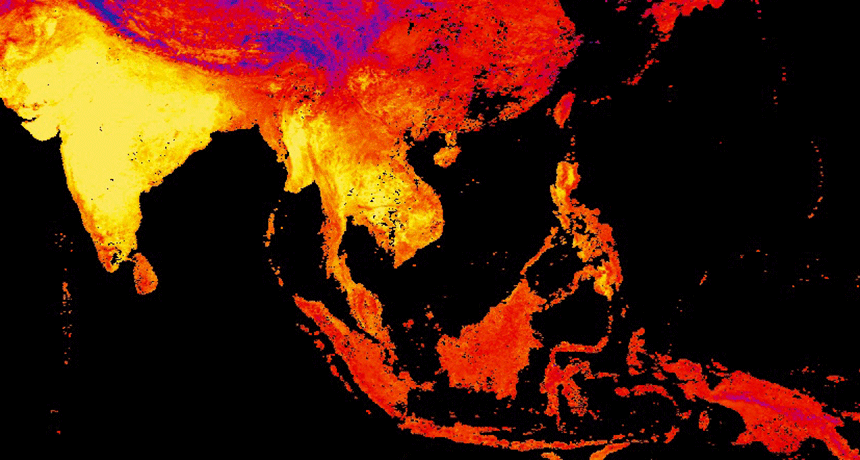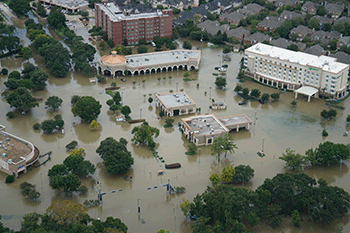Scientists at last link some extreme weather to human activities
Researchers ruled out 2016’s deadly heat and ocean-warming events as simply being due to chance

This false-color map shows Southeast Asia sweltering under a record-breaking heat wave in April 2016 (yellow shows highest temperatures). A strong El Niño contributed to the heat. But a new study concludes that the temperatures would not have reached such extremes without human influence on the climate.
Reto Stockli/NASA Earth Observatory Team, MODIS Land Science Team
NEW ORLEANS, La. — For the first time, scientists have definitively linked human-caused climate change to extreme weather events.
Bouts of extreme weather occur every year. But a handful of events in 2016 had some help. These included a deadly heat wave that swept across Asia. It was one of several events that could not have been due solely to the natural ups and downs of climate.
That’s the finding of three new studies. They were part of a special December 13, 2017 issue of the Bulletin of the American Meteorological Society. (It’s also known as BAMS.)
Jeff Rosenfeld is editor in chief of BAMS. These new findings are a game changer — or should at least be a conversation changer, he says. Indeed, he maintains, “We can no longer be shy about talking about the connection between human causes of climate change and weather.”
Rosenfeld spoke at a news conference timed to the studies’ release. It was held at the fall meeting, here, of the American Geophysical Union (AGU).
For the past six years, BAMS has published a December issue containing research on extreme weather events the previous year. That research has sought to separate the role of human-caused climate change from natural variability. Both can contribute to types of extreme weather, such as heat waves, record rains or blistering cold. The goal from the start has been to find ways to improve the science of such “attribution,” said Stephanie Herring. She was lead editor of the latest BAMS issue and works at the National Centers for Environmental Information in Boulder, Colo. They’re part of the National Oceanic and Atmospheric Administration.
To date, BAMS has published 137 attribution studies. Herring says that this year is the first time any of them concluded a weather event was so extreme that it was outside the bounds of natural variability. And this year, researchers identified three such events.
Attributing extreme weather
The Asian heat wave was one. Another was the record global heat. In fact, 2016 was the hottest year ever recorded.
The third event was the growth and persistence of a large swath of high ocean temperatures. Located in the Bering Sea off the coast of Alaska, it was nicknamed “the blob.” Those unusually warm waters lingered for about 18 months. They have been linked to mass die-offs of birds and sharply reduced codfish populations in the Gulf of Alaska. They also altered weather in such a way that California ended up with a severe drought.
The studies in the new issue looked at more events than just these three. Most of the 24 others found it highly likely that there was some human influence on those events. Yet those reports stopped short of saying these events could not be due solely to natural weather variability. In other words, there was some chance those events might have happened even without human-driven climate change.
El Niño (NEEN-yo) is a periodic warming of Pacific Ocean waters. And one study found that an already strong El Niño in 2016 probably was enhanced by factors associated with human activities (such as atmospheric warming due to fossil-fuel use). That El Niño contributed to drought and famine conditions in southern Africa.
Another study looked at the source of a heightened risk for coral bleaching along the Great Barrier Reef off the northeast coast of Australia. Here, the main factor driving the increase was greenhouse gases. They were shown to have driven warming of sea-surface temperatures in the nearby Coral Sea.
But not all of the studies linked 2016’s extreme events to human activity. There were record-breaking rains in southeastern Australia between July and September, for example. That had been due to natural variability, one study showed.
Looking forward
With hurricanes, wildfires and drought, 2017 is chock-full of extreme-event candidates for next year’s crop of BAMS studies. Already, three analyses have looked at Hurricane Harvey’s extreme rains. Two of those studies were presented at this year’s AGU meeting. The storm dropped about 1.3 meters (4.3 feet) of water on Houston, Texas, and surrounding areas in August. The three studies were discussed at a separate news conference on December 13. Human influence likely upped the hurricane’s total rainfall, they concluded. By how much? It was from at least 15 percent to 19 percent.

“I think [the BAMS studies] speak to the profound nature of the impacts we’re now seeing,” says Michael Mann. He was not involved in any of the studies, but is a climate scientist. He works at Pennsylvania State University in University Park.
Mann says he’s concerned that many researchers are too focused on quantifying how much people are responsible for certain events. Of more interest, he says, might be measuring how much human influence affects various planetary processes. One example, he notes, is the established link between rising temperatures and increased moisture in the atmosphere. This is another factor implicated in Hurricane Harvey’s extreme rains.
There’s also another possible issue with attribution science, he notes. The computer programs now used to model climate simply may not be capable of capturing some of the subtle changes in the climate and in the oceans. This is a particular danger when it comes to studies that claim to find no link to human activities.
Andrew King made the same point at the news conference. He’s a climate scientist at the University of Melbourne in Australia. He authored the paper on Australia’s severe rainfall.
“When we find no clear signal for climate change, there might not have been a human influence on the event.” Or, he notes, it might be that “the particular factors of the event that were investigated were not influenced by climate change.” But, he adds, “It’s also possible that the given tools we have today can’t find this climate-change signal.”
Rosenfeld noted that people tend to talk about the long odds of an extreme weather event happening. By that, he means that human events are unlikely to affect extreme weather — yet not impossible. In fact, some studies are now beginning to argue that climate change was a necessary condition for some extreme-weather events.
That means discussions about long odds no longer apply, he concludes. “These are new weather extremes made possible by a new climate.”







